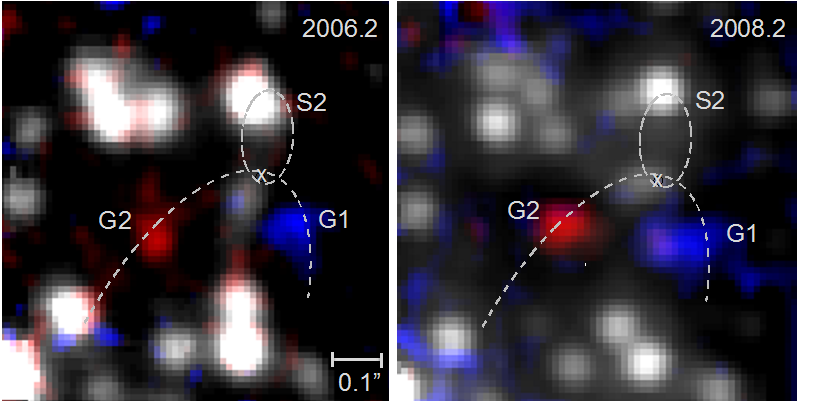Oumuamua and Borisov astronomy: alien ships or large rocks?
The astronomer Rafael Bachiller reveals to us in this series the most spectacular phenomena of the Cosmos.
Topics of exciting research, astronomical adventures and scientific news about the Universe analyzed in depth.
A new study tries to find the origin of the bright flashes that were observed in May 2019 around Sgr A *, the supermassive black hole that inhabits the center of the Milky Way.
An interrupted lethargy
Like virtually all galaxies, the Milky Way contains a supermassive black hole at its center.
This is called Sgr A * (seen in the constellation Sagittarius), is about 26,000 light years distant, and is 4.6 million times more massive than the Sun.
The material that accumulates in the vicinity of the galactic center is inexorably falling into the black hole.
This accretion phenomenon normally takes place gradually and without major shocks.
It is a much gentler process than we observe in other more massive, active galaxies, where black holes appear to be continually engulfing large amounts of material, resulting in bright flashes and jets of matter.
However, in May 2019, Sgr A * seemed to wake up from its slumber and increased its brightness (in the near infrared) by a factor of 100. This brightening lasted two and a half hours, it was the most intense ever observed in our galactic center. , and began a period of activity - with other minor flashes - that lasted for months.
Astronomers still wonder what was the phenomenon that caused the brightening and a study published now by Elena Murchikova (of the Institute for Advanced Study in Princeton) tries to provide answers.
Stars and clouds
Murchikova believes that there may be two types of objects near the galactic center to create the excess material that collapses on the black hole, creating the sparkles as it falls.
On the one hand, there is the population of stars that are orbiting very close to Sgr A *.
From these stars, known as 'S stars', violent winds blow whose material can be trapped by the black hole.
On the other hand, fuzzy and faint objects, known as 'G objects', orbit very close to Sgr A *.
These large objects look like clouds of dusty gas that, in turn, could include some stars.
As they describe their orbits, these nebulosities could be stretched by the intense gravitational effect and progressively disintegrate.
When these clouds are in the points of their orbits closest to the black hole (the periaster), they can lose a good part of their material that would fall on the monster.
The attached image shows two of these nebulosities, G1 and G2, as observed in the years 2006 and 2008. The orbit of the star S2 and the position of Sgr A * indicated with a cross are also shown.
Murchikova has calculated how much material can be detached from these clouds and how long it would take for that material to fall on Sgr A *.
From these calculations, the astronomer concludes that the material thrown into space by G1 and G2 in their periastrums is enough to explain the flashes observed in 2019.
The G1 and G2 objects observed in 2006 and 2008 ESO / MPE / VLT
If the calculations and interpretation are correct, the flashing can be expected to cease and Sgr A * to return to its dormant state, in which it would remain for a long time.
But if we observe new flashes in the near future, we would have to look for an alternative cause to the one proposed by Elena Murchikova.
Sgr A * is the closest supermassive black hole to Earth.
It is a magnificent laboratory where to investigate a whole series of fascinating phenomena both at the astrophysical level and in the field of general relativity.
The monitoring of this spectacular star is a priority in all the observatories of the world from which it is visible, and the observations that are made, night after night, and at all wavelengths, will end up revealing the origin of its mysterious flashes without ambiguity. .
Elena Murchikova's article, entitled "S0-2 Star, G1- and G2-objects, and Flaring Activity of the Milky Way's Galactic Center Black Hole in 2019", has been published in a recent issue of
The Astrophysical Journal Letters.
and can be consulted in
this link
____________________________________________________________________________
Rafael Bachiller
is director of
the National Astronomical Observatory
(National Geographic Institute) and academic of the
Royal Academy of Doctors of Spain
.
According to the criteria of The Trust Project
Know more
Science and Health
science
EnvironmentSpain, the third EU country most responsible for tropical deforestation
They find a suitcase with 185 baby giant tortoises at the Galapagos airport
BiodiversityThe 'Vatican' of plants
See links of interest
Work calendar
Home THE WORLD TODAY
Rafa Nadal - Cameron Norrie, live
FC Augsburg - 1. FC Cologne
Barça - Zenit Saint Petersburg
Real Zaragoza - Sporting de Gijón

